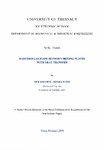| dc.contributor.advisor | Βαλουγεώργης, Δημήτριος | el |
| dc.creator | Μισδανίτης, Σεραφείμ Γεώργιος | el |
| dc.date.accessioned | 2015-07-24T12:23:35Z | |
| dc.date.available | 2015-07-24T12:23:35Z | |
| dc.date.issued | 2009 | |
| dc.identifier.other | 7047 | |
| dc.identifier.uri | http://hdl.handle.net/11615/14230 | en |
| dc.identifier.uri | http://dx.doi.org/10.26253/heal.uth.2003 | |
| dc.description.abstract | The state of a single-species monatomic gas under rarefied conditions remains a
fundamental research problem with important applications. The most powerful
approaches to handle this type of flows is the Direct Simulation Monte Carlo method and
the kinetic theory. Here, we apply the latter one.
In particular, we apply the non-linear Bhatnagar-Gross-Krook (BGK) and Shakhov
(S) kinetic model equations, subject to Maxwell diffuse boundary conditions, to solve the
one dimensional compressible Couette flow problem coupled with heat transfer. The
intermolecular collisions are modeled by the inverse power law model. The
computational scheme is based on finite differencing in the physical space and on the
discrete velocity method in the molecular velocity space..
The numerical solution is valid in the whole range of the Knudsen number. Its
accuracy has been tested in several ways including the recovery of the corresponding
analytical solutions at the free molecular and hydrodynamic regimes and the successful
comparison with previous results. In all cases excellent agreement has been
demonstrated. In addition, a detailed comparison between the simple BGK model with
the more sophisticated Shakhov model, clearly indicates that the BGK model remains a
reliable choice at least for engineering purposes. Also, the application of the hard sphere
and Maxwell molecular models for intermolecular interaction shows that the
intermolecular potential model does not significantly influence the flow properties and
characteristics.
Results for the bulk quantities of velocity, temperature, vertical and horizontal heat
flux, density, pressure and shear stress have been presented in terms of the three dimensionless parameters describing the flow configuration, namely the rarefaction
parameter, the temperature ratio and the relative velocity of the plates.
Several interesting issues related to the combined momentum and heat transfer effects
have been studied. It has been found that the velocity slip and the temperature jump are
larger at the hot plate compared to the ones at the cold plate. Moreover, the pressure
distribution is a function of the spatial variable in the transition regime. This is also due
to the rarefaction of the flow. Even more, the flow is characterized by the presence of an
horizontal axial heat flux, which increases as the rarefaction of the gas is increased and
which is present only when both velocity and temperature gradients exist in the flow.
This is a non-equilibrium cross effect and it vanishes at the hydrodynamic limit. | en |
| dc.language.iso | en | en |
| dc.rights | Attribution-NonCommercial-NoDerivatives 4.0 International | en |
| dc.rights.uri | http://creativecommons.org/licenses/by-nc-nd/4.0/ | en |
| dc.subject.other | ΘΕΡΜΟΤΗΤΑ, ΜΕΤΑΦΟΡΑ ΤΗΣ | el |
| dc.subject.other | ΡΕΥΣΤΟΔΥΝΑΜΙΚΗ | el |
| dc.title | Rarefied gas flow between moving plates with heat transfer | en |
| dc.type | masterThesis | en |
| heal.recordProvider | Πανεπιστήμιο Θεσσαλίας - Βιβλιοθήκη και Κέντρο Πληροφόρησης | el |
| heal.academicPublisher | Πανεπιστήμιο Θεσσαλίας. Πολυτεχνική Σχολή. Τμήμα Μηχανολόγων Μηχανικών. | el |
| heal.academicPublisherID | uth | en |
| heal.fullTextAvailability | true | en |
| dc.rights.accessRights | free | en |
| dc.contributor.committeeMember | Μποντόζογλου, Βασίλειος | el |
| dc.contributor.committeeMember | Μαθιουλάκης, Δημήτριος | el |



